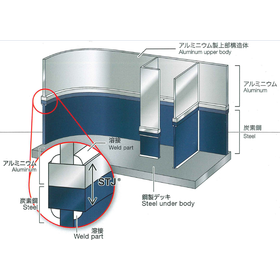Electrode materials and cladding for heat sinks that achieve low cost and lightweight.
We achieve cost reduction and weight reduction without compromising the material properties in materials such as large current contact materials, electrode materials, and heat exchange materials.
By replacing copper used in materials such as high current contact materials, electrode materials, and heat exchange materials (heat sinks) with "copper/aluminum clad," we respond to the needs for cost reduction and weight reduction. Additionally, our explosive crimping technology is a cold joining method that does not apply heat to the materials, making it difficult for impurities such as alloy layers to form at the bonding interface between copper and aluminum. This results in low electrical resistance and conductivity close to the theoretical values of the materials. ■ETJ(R) Electrical Transition Joint 【Features】 1. Excellent electrical properties. 2. Superior mechanical properties. It has high bonding strength and demonstrates robust characteristics in bending and tensile tests. 3. Excellent heat resistance. The bonding strength does not change even after 5,000 cycles of thermal fatigue testing at 250°C and 25°C. 4. Regarding galvanic corrosion: Our clad is fully bonded, preventing electrolytes from entering the interface, allowing us to prevent galvanic corrosion by simply applying protective paint to the externally exposed surfaces. *For more details, please refer to the PDF materials or feel free to contact us.
Inquire About This Product
basic information
ETJ(R) is used in various applications such as metal refining, salt electrolysis equipment, and contact materials for charging device components.
Price range
Delivery Time
Applications/Examples of results
Metal smelting, salt electrolysis equipment, charger components, heat sinks, etc.
catalog(1)
Download All CatalogsCompany information
BA Clad is a clad steel plate manufactured by Asahi Kasei using the explosive cladding method, and it has received high praise in various fields since its release. The explosive cladding method utilizes the enormous energy released during an explosion to instantaneously bond metal plates together, thereby producing clad steel plates. BA Clad is used for plants and equipment in the chemical industry, petroleum refining, petrochemicals, and power generation, and is exported widely both domestically and internationally, either as flat plates or various components. It is used as corrosion-resistant and heat-resistant structural materials for power plant condenser tube sheets, heat exchanger tube sheets for chemical plants, shells, and end plates, among others, and its applications are continually expanding to include rolling mill liners, electrodes, cryogenic joints, ultra-high vacuum joints, and structural joints for ships and LNG tankers. We offer solutions related to metal joining (dissimilar metal joining, similar metal joining) and cladding. We can provide joining characteristics such as material properties, joining strength, minimization of alloying at the joining interface, and joining area, which are difficult to achieve with other joining methods, such as various welding techniques, diffusion bonding (roll bonding, HIP, etc.), friction joining (friction welding, friction stir welding (FSW)), electromagnetic pressure bonding, brazing, plating, and thermal spraying.






![Low-temperature thermal spraying clad "CS Clad" [Special Metal Excel]](https://image.mono.ipros.com/public/product/image/025/2000551689/IPROS90989907450074193047.jpeg?w=280&h=280)


